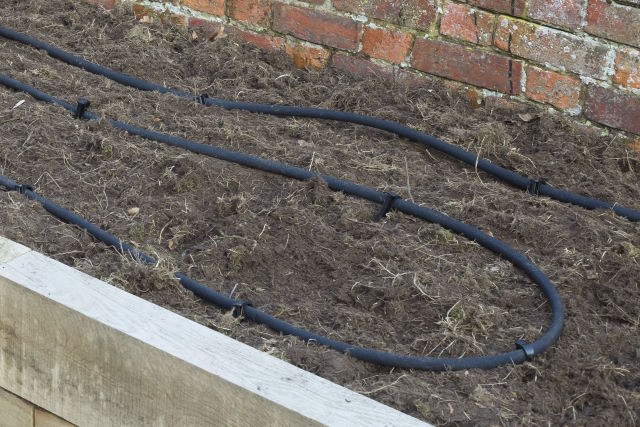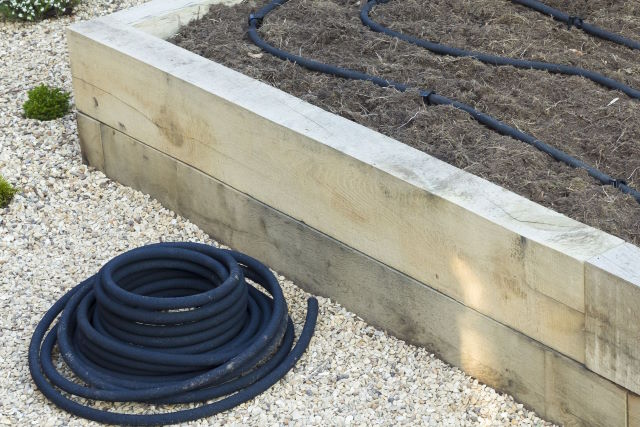
Regular watering is an essential part of maintaining a healthy and thriving garden. One of the most effective methods to ensure proper watering is using a soaker hose as an alternative to regular use of garden hoses.
This article will explore the factors affecting soaker hose efficiency and provide guidance on how long to run a soaker hose for optimal results.
Contents
How Long Should You Run a Soaker Hose For
Firstly, it’s important to remember that deep watering is much better in most situations. This means watering your garden for a longer period and less often.
Vegetable Garden
For a vegetable garden, running a soaker hose for 30 minutes to an hour, two to three times a week is usually sufficient.

This should allow water to pass the top few inches of soil and provide the plants with enough water without overwatering them.
Overwatering can lead to root rot.
For deep-rooted vegetables such as tomatoes, a longer watering time of up to 2 hours is needed.
Sandy Soil
Sandy soil drains water quickly, so a soaker hose should be run for shorter periods but more frequently. Around 30 minutes, three to four times a week, should provide adequate watering for sandy soil.
Clay Soil
Clay soil retains water longer, so running a soaker hose for longer periods but less frequently is ideal. Approximately 45 minutes to an hour, once or twice a week, should be sufficient for clay soil.
Monitoring and Adjusting Watering Time
The following will affect your soaker hose efficiency and will require the watering time to be adjusted.
Water Pressure
Soaker hoses are pretty great because they don’t shoot water out at high pressure but water pressure is a critical factor when using a soaker hose.
Most gardeners simply connect the hose to a faucet and open it just a little bit to get a nice, slow trickle of water.
If the pressure inside the hose gets too high – maybe because your water pressure is just naturally strong, or because those pores are blocked – you might find that the hose doesn’t water evenly, or worse, it could split.

To avoid this, make sure you open the faucet just enough so that the water gently “sweats” from the surface of the hose. You can also use a pressure regulator which can help maintain a steady flow of water through the hose.
Soil Type
Different soil types, such as sandy soil or clay soil, can influence how long to run a soaker hose. Each type of soil has unique water absorption rates, which can affect the required watering time.
When you want to see how well your plants are being watered, gently dig into the soil near the hose. This lets you check how deep the water has soaked in.
Quick, frequent watering can lead to weaker, shallow roots. Deep watering promotes deep root growth which makes them less susceptible to drought.
For most smaller plants, you’ll want the soil to be moist about 6 to 8 inches (15 to 20 centimeters) below the surface. Bigger shrubs and trees will need an even deeper soak.
If you notice the ground is too wet, try reducing the time your hose runs. On the other hand, if the soil is still too dry after watering, let the hose run for a bit longer. Giving your plants a good, thorough soak less often is better for their root development.
Type of Plants
Different types of plants have distinct water requirements. Vegetables and shallow root systems may need more frequent watering, while other plants might require deeper watering.
Weather Conditions
Warmer weather and summer months may call for increased watering, while cooler weather might necessitate less frequent watering. Overhead watering is not recommended, particularly in hot weather as it can be inefficient with water wastage and may promote fungi growth potentially causing disease.
How Much Water Does A Soaker Hose Disperse?
A typical 5/8-inch soaker hose can distribute about an inch of water to your plants in just over 3 hours. Just remember that the water pressure from your spigot and the length of the hose can influence the water output.
Usually, your landscaping plants will be pretty content with one or two inches of water per week.
Keep in mind that water pressure and hose length can differ, so it might take a little trial and error to figure out your water flow.
A great tip for checking your water usage is to pop a flow-rate meter onto your water line, right between the spigot and the soaker hose.
Understanding Soaker Hoses
Soaker hoses are an excellent choice for garden irrigation and for watering your garden without a hosepipe. They deliver water directly to the bases of plants. This helps to minimize water waste and maintain adequate soil moisture levels.
Recycled rubber and polyethylene are commonly used materials for soaker hoses. These materials are durable and also environmentally friendly.
A garden soaker hose will usually consist of a flat hose pipe that weeps water along the entire length of the hose. Drip irrigation or drip hoses are different and allow water out of emitters or drippers.
Setting Up a Soaker Hose System
Pressure Regulator
A pressure regulator is essential to control the water pressure in a soaker hose irrigation system. By maintaining a consistent water flow, you can ensure proper watering of your garden without worrying about getting the correct water output on your faucet each time you use it.
Using A Timer
A timer is a great way to not need to remember to water your plants. Begin by setting your timer to let the water flow for an hour.
As soon as the hour is up, gently dig into the soil near the hose. This allows you to see how far the water has penetrated.
Plan to water your garden two or three times a week.
Keep an eye on how your plants are doing so you can make adjustments as needed. While a consistent watering routine is excellent for your garden’s well-being, don’t be afraid to make some tweaks here and there to ensure optimal growth.
Hose Splitter
Hose splitters allow you to connect multiple soaker hoses to a single water source. This is useful for larger gardens or those with various watering needs.
Tent Pegs
Tent pegs help secure soaker hoses in place, preventing them from moving or becoming tangled. These must be large enough to not restrict water flow.
Conclusion
Determining how long to run a soaker hose depends on various factors, including soil type, type of plants, and weather conditions.
Regularly monitoring and adjusting your watering schedule based on these factors will help you achieve optimal garden health. With a bit of trial and error, you can find the perfect balance for your unique garden situation.
FAQs
How do I know if my soaker hose is working properly?
You can check for even water distribution by observing the wet band of soil along the hose after running it for a short period. Also, keep an eye on your plants for signs of overwatering or underwatering.
Can I use a timer with my soaker hose?
Yes, advanced hose timers are available that can be programmed to automatically turn your soaker hose on and off according to a set schedule. Remember to adjust these depending on weather changes.
How deep should I bury my soaker hose?
Soaker hoses should be placed on the surface or buried 2-4 inches beneath the soil, depending on the type of plants and their root systems.
Can I use a soaker hose for flower beds?
Yes, soaker hoses are an excellent choice for watering flower beds, as they deliver water directly to the base of the plants and help to conserve water.
Do I need a separate soaker hose for each row of plants in my garden?
This depends on the size of your garden and the water flow of your soaker hose. In some cases, one soaker hose can cover multiple rows, while in larger gardens or gardens with different watering needs, multiple hoses may be required.
